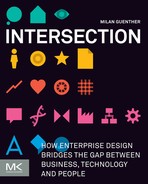9
Design Process
The Enterprise Design framework is meant to be applied in design processes, both as a vocabulary and a way of thinking about complex problem settings. This chapter proposes a generic process that is applicable to strategic design projects of all kinds, going from an initial preparation phase, through stages of research, concept and ideation all the way to bringing the ideas to life in implementation. Each step describes the key elements to take into account, and maps the activities to the twenty aspects of the Enterprise Design framework. This is meant to guide your own individual approach, and help you select professionals to involve during the process.
The process we propose has seven phases: Prepare, Discover, Define, Ideate, Validate, Implement, and Deliver. This includes the five phases which are a part of almost all generic process models for design work, plus a preparation phase at the beginning and a change or transformation phase at the end, to account for the specifics of the enterprise context. The process also incorporates two different cycles of iteration, a small one inside a project, and a big one as a roadmap of sequential projects. While lean or agile approaches that focus on delivering results quickly work in many small iterations, formal methodologies applied to large projects put an emphasis on a clear up-front definition of the intended outcomes. Whatever the chosen approach, design projects usually go through all these stages regardless of what process they employ, but with different degrees of speed and attention to detail.
In reality, such a process does not exist. There is no clear point in time when a project switches from research and analysis to concept development and ideation, and then to implementation and change, so a formal separation between these phases is unsuitable to reflect the reality of design work. Likewise, a design project, especially a courageous and daring one, requires adapting the approach to the specifics of the design challenge. Every enterprise is different, and projects can start from different points and work towards different objectives.
Properly gaining control of the design process tends to feel like one is losing control of the design process.
Matthew Frederick in 101 Things I Learned in Architecture School
Redesigning an enterprise is difficult—the sheer number of generic aspects described in the previous part of this book and their interrelationships is a good indicator of how complex and challenging such an endeavor can be. Often, it seems much easier to approach a project as though it were separate from the wider environment of the enterprise.
Our experience tells us that it is worth taking on the challenge of an overarching enterprise-wide approach. This opens up the design process to questions you might not be aware are relevant at the beginning, but later on prove to be critical. Spending time understanding how the different aspects influence your project enables you to make informed conceptual decisions, aligning those elements to a common goal.
By doing this based on a holistic model, organizations can ensure the viability, desirability, and feasibility of an intended transformation. It allows them to make the consequences of a transformation visible, and iteratively adapt to the reality of their enterprise.
Like other design process models, this model puts an emphasis on the early phases of a project, where the design practice makes its main contribution of defining a potential future of the enterprise. In subsequent phases of implementation and delivery, design switches to a supporting role. At that point, questions of engineering, governance, and change take center stage. The design team takes on tasks of executing and producing everything needed to make the vision reality, managing quality and transformation processes, and launching further projects for missing pieces or a subsequent iteration.
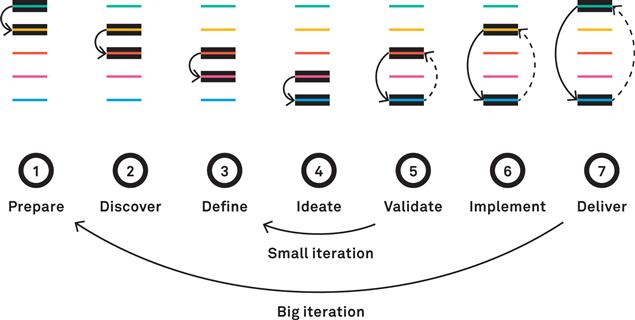
BIG PICTURE / ANATOMY
2 DISCOVER: EXPLORING THE PROBLEM SPACE
ANATOMY / FRAMES
3 DEFINE: DEVELOPING A SOLUTION APPROACH
FRAMES / DESIGN SPACE
4 IDEATE: GIVING A FORM TO THE SOLUTION COMPONENTS
DESIGN SPACE / RENDERING
5 VALIDATE: PROTOTYPING, SIMULATION AND TESTING
RENDERING / FRAMES
6 IMPLEMENT: PRODUCTION AND DEVELOPMENT
RENDERING / ANATOMY
7 DELIVER: DEPLOYMENT AND TRANSFORMATION
RENDERING / BIG PICTURE
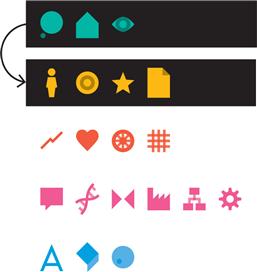
 Prepare
Prepare
Obtain an initial briefing and perform a high-level scan to develop a Big picture view of the enterprise environment, and understand how it addresses the three universal qualities. Develop a first understanding about its anatomy in stakeholder interviews and workshops.
Activities
Obtain an initial client briefing from the party commissioning a strategic design project
Set project objectives, overall planning, and timetables
Identify the most relevant aspects and establish a project team mixing people with multiple relevant backgrounds and design expertise
Conduct interviews and stakeholder workshops to develop a high-level view on the enterprise
Conduct initial desk research to find out about the history, structure, and positioning of the enterprise, and benchmark the offerings and assets relevant to the project
Establish a basic vocabulary of terms and concepts
Set the scope of the intended transformation
Make an initial plan and organize the people involved in the project, assemble a diverse team, and get started
Challenges
Getting access to all relevant stakeholders
Finding a viable compromise between high aspirations and a realistic scope
Avoiding falling in love with initial ideas, which leads to a narrow and predetermined project scope
Typical Techniques
Stakeholder Workshops
Interviews
Briefing Document
Project Scoping
Big Picture
The focus of the initial project phase is to develop a high-level view of the enterprise. it starts by engaging in an intense dialogue with the client or party commissioning the design work, understanding what the enterprise is about and where people see its future. using the interrelated big picture aspects of identity, architecture, and experience as the guiding topics of this exchange helps to focus on the universal qualities that make the enterprise, drawing a holistic picture of the design challenge.
IDENTITY
![]() elaborate with project stakeholders how people think about the enterprise, what it is about, and what it stands for
elaborate with project stakeholders how people think about the enterprise, what it is about, and what it stands for
ARCHITECTURE
![]() evaluate the structures of the enterprise, how it works or is intended to work, and the portfolio of formalized systems applied
evaluate the structures of the enterprise, how it works or is intended to work, and the portfolio of formalized systems applied
EXPERIENCE
![]() examine how and where people are experiencing the enterprise, and define what role it seeks to play in their lives
examine how and where people are experiencing the enterprise, and define what role it seeks to play in their lives
Anatomy
The Anatomy aspects are very useful in this phase for developing a first rough blueprint of the enterprise to be transformed, and identifying the particular elements that are relevant for a specific project. The goal is to develop a comprehensive view of actors and their journeys across touchpoints, as well as services being provided and content being exchanged. This is the prerequisite for the following phases or research and analysis to inform the project, since it provides the list of enterprise elements potentially subject to design work.
ACTORS
determine the key stakeholders the project owner intends to address and map their relationships with the enterprise.![]()
TOUCHPOINTS
find out about the journeys actors are experiencing across key interactions with the enterprise, and the channels used to facilitate them.![]()
SERVICES
define and describe activities the enterprise carries out to generate benefits for the actors addressed in terms of services.![]()
CONTENT
list relevant content elements made available in the enterprise as part of its activities.![]()
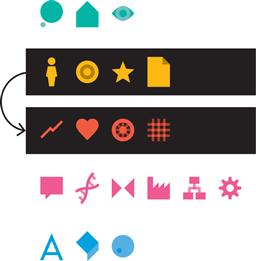
 Discover
Discover
Perform research and analysis of the anatomy of the enterprise, to gain an overview of the elements to consider. Frame the problem space by a deep exploration from different Perspectives with the help of external input, to develop conceptual models of the enterprise and generate ideas for a transformation.
Activities
Perform a detailed investigation of the Anatomy of the enterprise, if possible backed by quantitative data on the way it currently functions
Conduct qualitative research working with clients or business owners, prospective target groups of the design process, technology and domain experts
Model the current situation from different perspectives, capturing the way things are now, and envisioning a potential transformation as well as approaches to achieve it
Perform a detailed analysis of the research results, applying the four Frames to filter relevant bits out of the findings
Map the touchpoints, services, content elements, and actors and how they interrelate and interact in the enterprise space,
Formulate a set of strategic recommendations based on the research findings as input for the Definition phase
Challenges
Avoiding getting lost in the details of research and analysis activities and losing the connection with the design challenge to be solved
Avoiding commiting to ideas coming out of initial research from just one perspective and failing to account for the remaining aspects
Finding a good balance between effort put into research activities and a transition to the next phase
Translating research results into actionable insights for Definition and Ideation
Gathering suitable data to perform quantitative analysis
Anatomy
As the second phase puts an emphasis on deeply comprehending the enterprise as a problem space, the Anatomy aspects are used to evaluate the enterprise and the way it works (or is supposed to work, for a startup), as the environment for the design work. This auditing activity has the goal of analyzing the enterprise elements so that they can be mapped and prioritized based on the objectives of a design project. Ideally, this is informed by conducting quantitative research, such as gathering data from information systems. This is then used to create a mapping of the current or planned enterprise elements and how they are related.
ACTORS
validate and complete the initial group of actors identified based on a mapping of stakeholders, and analyze how these groups are addressed.![]()
TOUCHPOINTS
analyze the contacts actors have with the enterprise, and identify the journey they are taking across them along with key situations to consider in the design.![]()
SERVICES
develop a comprehensive view of activities being carried out in the enterprise, including the steps they involve, their interdependencies, and benefits they create for actors.![]()
CONTENT
inventory content assets being exchanged and made available in the enterprise to support its range of activities, mapping content elements to their usage.![]()
Frames
The different Frames come into play to ground and define the design challenge, establish a good direction to go, and inform the design decisions to be made. They are the basis for conducting deep qualitative research with people involved into the project in different roles, and seeking input from a variety of sources. Findings from the research activities are used to develop simplified conceptual models describing the enterprise based on this input. Applying the four perspectives ensures that the research and analysis activities take a balanced approach with regards to the different perspectives to consider.
BUSINESS
![]() explore and understand the markets the enterprise addresses, formulate the design challenge in business terms, and learn about the business rationale and business models driving the enterprise.
explore and understand the markets the enterprise addresses, formulate the design challenge in business terms, and learn about the business rationale and business models driving the enterprise.
PEOPLE
![]() conduct human-centric research with people to achieve an in-depth understanding about their characteristics, goals, and social and physical context, and develop empathy to inform the design process.
conduct human-centric research with people to achieve an in-depth understanding about their characteristics, goals, and social and physical context, and develop empathy to inform the design process.
FUNCTION
![]() understand the functional context of goals and processes to be supported, and envision potential functional components to support this context.
understand the functional context of goals and processes to be supported, and envision potential functional components to support this context.
STRUCTURE
![]() develop a model mapping the structural context of the enterprise, and capturing key objects and relationships to be reflected in the design process and envisioning a transformation.
develop a model mapping the structural context of the enterprise, and capturing key objects and relationships to be reflected in the design process and envisioning a transformation.

 Define
Define
Use the research results to envision a possible future state of the enterprise applying different Frames, and to inform the development of a conceptual Design Space that outlines how the Enterprise Design could work.
Steps
Use the four Frames to identify key challenges to be tackled and formulate Design Themes guiding all further activities
Make sense of the insights gained in the preceding phase to develop an informed approach to solve the problems identified
Use these themes to envision a potential future state of the enterprise and ways to make it happen
Work with your multi-disciplinary design team to collaboratively explore different possibilities how the results of the project might transform the enterprise
Apply the four Frames to model the future of the enterprise generating new business models, imagining its impact on people’s lives, and modeling the structures and functions it puts in place
Use the six conceptual aspects to bridge these viewpoints and map the Design Space of decisions and ideas
Define how the future enterprise should is supposed to work in conceptual models, aligning divergent concerns and plotting a common course toward a coherent vision
Generate initial ideas on visible and tangible outcomes to implement that vision in real life
Challenges
Making choices in a jungle of insights, requirements, ideas, feedback from peers, opinions of important influencers, and personal experiences
Boiling down the design challenge to a set of key issues to be tackled, taking into account all inputs from external influencers and a multidisciplinary design team
Keeping a focus on the Design Themes identified and avoiding the temptation to tackle everything at once
Dealing with conflicting goals that arise from applying different Frames and stakeholder perspectives
Frames
The thorough research activities executed in the preceding phase result in an extensive body of findings, as well as key themes to guide the definition of potential solutions. At this point the focus of the design process switches from inquiry to the definition of an intended transformation. In order to translate these findings into actionable insights that open the path to a solution definition, the Frames are used to identify a set of fundamental Design Themes to guide all further activities, and to model a potential future state of the enterprise. Depending on your individual design challenge and enterprise context, you might approach this work in a traditional design studio setting, or working together with members of the target group, business owners, and experts from across the organization in a co-creative approach.
BUSINESS
![]() brainstorm multiple evolved or new business models based on the exploration of the current business, experimenting with bold ideas to achieve market differentiation and better ways of working.
brainstorm multiple evolved or new business models based on the exploration of the current business, experimenting with bold ideas to achieve market differentiation and better ways of working.
PEOPLE
![]() imagine different ways to improve people’s lives based on the findings from a human- centric perspective, and make the outcomes fit into people’s lives, making them valuable and engaging.
imagine different ways to improve people’s lives based on the findings from a human- centric perspective, and make the outcomes fit into people’s lives, making them valuable and engaging.
FUNCTION
gather a collection of requirements for the intended outcomes to fulfill, in order to support goals and processes in the evolved enterprise, taking on their role as functional components.![]()
STRUCTURE
work on evolved structural models, taking into account the insights about the domain, the outcomes of the design process, and the required transformation of other parts of the overall system.![]()
Design Space
The six aspects of the Design Space come into play in this phase, guiding all conceptual design decisions that define what desired target state the outcomes should be designed to support, and how these pieces fit together as a whole. This involves thinking about the conceptual aspects as the synthesis of different visions of a potential future state. The process expands to defining the details of the intended transformation and enabling us to envision the impact on the way people interact and communicate, clarifying how it helps the enterprise do what it has been created for.
COMMUNICATION
envision how your design will support people engaging in communication processes, and establishing the exchange of information, as part of the business activities. Formulate key messages and model communication processes, to reach audiences and support and sustain the dialogue.![]()
INFORMATION
![]() envision how enterprise information will be handled in your design. Define classification systems and delivery channels that proactively provide information to their audience where it makes sense, but enable people to actively search and find what they are looking for in all other cases.
envision how enterprise information will be handled in your design. Define classification systems and delivery channels that proactively provide information to their audience where it makes sense, but enable people to actively search and find what they are looking for in all other cases.
INTERACTION
![]() define the interactions and behaviors that you intend to support with your design, and envision suitable tools to turn these functions into a dialogue with people. Model and define the behaviors these tools should exhibit towards their users, keeping the larger context of people and organizational behavior in mind.
define the interactions and behaviors that you intend to support with your design, and envision suitable tools to turn these functions into a dialogue with people. Model and define the behaviors these tools should exhibit towards their users, keeping the larger context of people and organizational behavior in mind.
OPERATION
![]() define how the evolved enterprise should work by defining its operating model to support the functions it carries out. The operation aspect is about defining future work practices, considering the nature of tasks, their interdependencies, and balancing defined procedures against the need for flexibility.
define how the evolved enterprise should work by defining its operating model to support the functions it carries out. The operation aspect is about defining future work practices, considering the nature of tasks, their interdependencies, and balancing defined procedures against the need for flexibility.
ORGANIZATION
![]() define roles needed for the evolved enterprise to implement its business model, and how to make people work together as a team. Define organizational structures of formal and informal elements to sustain this change and engage the people involved.
define roles needed for the evolved enterprise to implement its business model, and how to make people work together as a team. Define organizational structures of formal and informal elements to sustain this change and engage the people involved.
TECHNOLOGY
![]() define ways to leverage and deploy technology as means to automate functions and structures of the evolved enterprise. Define technical options and capture their strengths and shortcomings with regards to the intended outcomes of the design process.
define ways to leverage and deploy technology as means to automate functions and structures of the evolved enterprise. Define technical options and capture their strengths and shortcomings with regards to the intended outcomes of the design process.
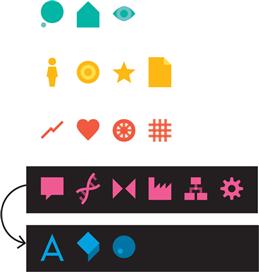
 Ideate
Ideate
Develop ideas about the potential outcomes of the design process, implementing the conceptual basis across the different aspects of the Design Space, and turn them into sketches or other forms of illustration that make the Rendering of the enterprise visible.
Activities
Use the Design Space aspects as starting points to develop ideas for innovation, inspired by research results and models defined in the preceding phase
Combine conceptual decisions with external sources of inspiration to open up the design space for unconventional approaches and surprising ideas
Engage in an open exchange among the design team and other parties involved, generating ideas and taking time to discuss them in depth
Combine visual thinking and rapid sketching to give these ideas a form, and communicate them as pictures of the future to team members and stakeholders
Produces sketches, more sketches, and even more sketches, knowing that most of them will not be taken further
Turn your ideas into concrete outcomes based on the three Rendering aspects, and envision what these elements of your design could be like
Work with expert designers to develop perceivable high-fidelity renderings of the outcomes, serving as evidences of the future enterprise and in turn influencing the conceptual decisions
Make Rendering elements high fidelity in terms of how well they represent the overall experience, not an isolated element
Explore, develop, and refine ideas collaboratively, continuously adding more detail and testing out different potential directions
Challenges
Encouraging team members and stakeholders to come up with bold ideas, and to actually sketch them out visually
Overcoming assumptions and predeterminations resulting from research results and conceptual work, questioning and informing design decisions instead of just implementing them
Evaluating design ideas based on how well they work, not the personal taste of team members or stakeholders
Not marginalizing the work of specialist designers, reducing their contribution to mere decoration
Typical techniques
Personal Design Journals
Brainstorming
Sketching
Storytelling
Storyboards
Visual Thinking
Design Space
By now you should have an idea of the intended outcomes of the design process, and a vision of the transformation that they should support. The conceptual models defined in the preceding phase provide a solid foundation for envisioning how the future enterprise will work and how the design should support it. The goal is still the transformation itself, which will only come to life in the tangible results of the design.
Therefore, the conceptual vision has to inform the creation of concrete Renderings of potential outcomes, based on creative thinking and a much greater level of detail. Key to this is working with sketches of some sort. Sketching allows us to capture this projected reality in illustrations of how the future might be like. In this stage of the design process, the team should keep the focus on a definition of what might be, not exactly the way it should look or feel.
COMMUNICATION
envision and sketch out communication devices and media to convey key messages and facilitate the dialogue with the audience, supporting the communication processes.![]()
INFORMATION
envision ways to make information available to people, and produce sketches on how to make it accessible via navigation and wayfinding systems, as well as suitable representations of information.![]()
INTERACTION
envision digitally supported systems to facilitate key interactions, and generate ideas to implement the defined behaviors by sketching out interfaces adapted to their respective use context.![]()
OPERATION
envision procedures and workflows to be executed to implement the operating model, and how they are supported with resources and artifacts such as machines, documents, or facilities.![]()
ORGANIZATION
envision how the organization design comes to life in daily practice, defining job and skill profiles and potential candidates, and sketching work environments and tools to support key tasks.![]()
TECHNOLOGY
envision how technical systems fulfill their part as components to automate the enterprise. Sketch their role in terms of the visible effects they produce as devices, products, or other outcomes that are made available to people.![]()
Rendering
Thinking conceptually enables the design team to plot a path to where you want to be, and how the design should support the intended transformation. The ideation phase is about turning this vision into actionable options to pursue, translating the thinking behind into concrete outcomes of the design process. The phase relies as much on insights and conceptual models as it does on creative thinking and good ideas. Decisions made and models produced based on the six aspects of the Design Space deliver the blueprints that define the Rendering elements. Their design needs to bring together these different aspects into logical arrangements and compositions, to shape a coherent whole. This involves working closely with specialist designers who have mastered the craft of formgiving in a certain medium, material or other design domain, to come up with strong ideas about what to produce in order to make a transformation happen.
SIGNS
![]() turn the enterprise into stories to be told, and design systems of signs to reach the audiences to be addressed. Envision media to drive this communication process, crossing the boundaries of channels and human senses.
turn the enterprise into stories to be told, and design systems of signs to reach the audiences to be addressed. Envision media to drive this communication process, crossing the boundaries of channels and human senses.
THINGS
![]() envision things as components of the enterprise and help facilitate its activities. Design tools, devices, software systems, or other objects as artifacts to embody both their utilitarian purposes together with their cultural meanings.
envision things as components of the enterprise and help facilitate its activities. Design tools, devices, software systems, or other objects as artifacts to embody both their utilitarian purposes together with their cultural meanings.
PLACES
![]() envision the space for the activities in the enterprise to happen. Design spaces to bring people in together in physical, virtual, and blended environments, making and connecting places people can go and relate to.
envision the space for the activities in the enterprise to happen. Design spaces to bring people in together in physical, virtual, and blended environments, making and connecting places people can go and relate to.
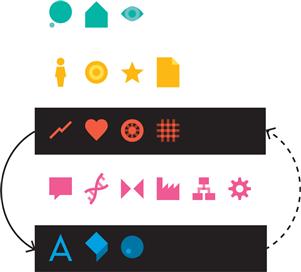
 Validate
Validate
Build prototypes that simulate how the Rendering of the enterprise would work, and validate these designs, looking at the outcomes using the four Frames. work with external people representing different perspectives, concerns, and knowledge areas relevant to the project. Iteratively develop and refine the concept based on validation results.
Activities
Design and develop prototypes that simulate the outcomes of the design project, simulating their role as Rendering elements of the future enterprise
Use these prototypes as a basis to discuss the potentials and shortcomings of Rendering elements within the design team engage external stakeholders and work with experts
Put your models into action in the larger context of the project, using the four Frames as a guide to validate the concerns of viability, meaningfulness, feasibility, and structural fit
Use the Design Themes to identify the concerns to address, and develop success criteria to decide out how to incorporate them into a prototype
Turn these themes into stories that illustrate how the outcomes work in real life and fulfill their role in the enterprise, and use them to guide the definition of states the prototypes support
Make use of whatever materials, techniques, or methods work best to create your prototypes, and use paper drawings or spreadsheets to create high-fidelity simulations
Make different prototypes adjusted to the audiences they are made for, and include areas with great uncertainty
Produce multiple prototypes to validate and revise them regularly, opening a dialogue with everyone involved and iteratively refining the solution
Challenges
Developing prototypes with just the right degree of fidelity that makes validation possible
Finding a suitable way to represent a design challenge in a prototype of some sort
Having a clear objective in mind when making a prototype, as a basis to decide how to build it
Combining different aspects in a single prototype where concerns converge, while making distinct ones for separate issues
Typical techniques
Prototyping
Simulation
Feedback
Sessions
Usability Testing
Roleplay
Surveys
Rendering
Validation of potential outcomes relies on the design and development of prototypes to be used as focal points to validate ideas, concepts, and design decisions. This phase of a design project is about creating representative models that enable the team and others involved to evaluate the design in action. Such models are essentially “fakes” of the actual results of a design project. The most promising outcomes of the preceding phase, which define the Rendering of the future enterprise, are the focal point of these efforts. While there are many potential techniques that might be used, on different scales and with varying degrees of fidelity, prototyping is best approached in an opportunistic manner. This involves using whatever materials and tools prove useful to build something that fits the purposes of validation and communication, and benefits greatly from working with experienced practitioners in a relevant field.
SIGNS
![]() create prototypes that show and tell the messages you need to get across to the audiences in the enterprise, encoded in media and signs such as graphic, text, or sound elements.
create prototypes that show and tell the messages you need to get across to the audiences in the enterprise, encoded in media and signs such as graphic, text, or sound elements.
THINGS
![]() create prototypes of the things being part of the design, shaped to be useful to people addressed, and simulating their functional and symbolic meanings.
create prototypes of the things being part of the design, shaped to be useful to people addressed, and simulating their functional and symbolic meanings.
PLACES
![]() create models of environments to be made available in the enterprise, as places for people to dwell in, prototyping them to reflect activities, movements, communication, and ambiance.
create models of environments to be made available in the enterprise, as places for people to dwell in, prototyping them to reflect activities, movements, communication, and ambiance.
Frames
In the context of design work, a prototype is primarily a communication device. The details of its technical implementation do not matter that much, but its capability to communicate the intent of a certain design to different audiences. Its essential purpose is to adequately represent different concerns to be addressed. The goal of prototyping is to create something that speaks to the people looking at it, to illustrate the different states of a designed outcome. It can be used to tell a story, try it out, gather feedback, provoke reactions, and explore alternatives.
The Frames of the Enterprise Design framework are used to look at prototypes from different perspectives, evaluating how well they work. They allow us to measure them against the priorities identified in earlier phases, as expressed in the fundamental Design Themes to be addressed. To do so, they have to be turned into stories or scenarios, which drive the creation of prototypes and their usage in validation sessions. Depending on the qualities to be measured, techniques applied may include test settings, reviews, co-creation, or even an acting exercise—anything to make the scenario come to life and simulate the effects of the actual design is a valid approach.
BUSINESS
assess the viability, working with business owners and key stakeholders to simulate how a solution would work from a business point of view. Simulate the business model in terms of revenue streams and value generation, and refine the underlying strategy.![]()
PEOPLE
work with people to assess the usability and desirability of the design, using working models that simulate the visible characteristics and qualities of the intended outcomes. Human-centric validation techniques help to develop new views and determine the next steps.![]()
FUNCTION
design prototypes to incorporate the outcomes’ functions and behaviors, and measure them against defined requirements. Work with implementation experts to refine their definition, decide on ways to implement potential solutions, and confirm their feasibility.![]()
STRUCTURE
work with domain experts to validate the accurate representation of the problem domain in your design, and the fit of intended outcomes into the structural context. Refine the to-be domain model to make structural design elements relevant to the enterprise.![]()
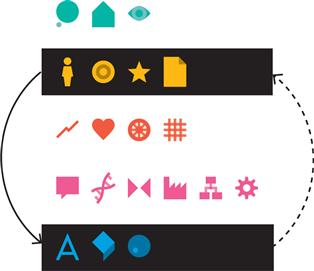
 Implement
Implement
produce the outcomes of the design project, turn them into documentation and specification to be shared with a wider audience of people involved in their implementation, and create a plan to actually build the components of the redefined enterprise.
Activities
Finalize the design of all outcomes, working with specialist designers and implementation experts
Develop a plan to implement and distribute all outcomes of the design project as components of the redefined enterprise
Specify activities and milestones as well as a longer roadmap to follow, and plan the business side of implementation
Align with the general project portfolio planning and change management initiatives in the organization
Plan subsequent projects to make the next steps of the larger roadmap happen after launch
Plan the migration of all technical or automation components where the design foresees a transformation
Prototype, document, and specify the outcomes to share them with everyone involved in their implementation
Produce the tangible artifacts, media, objects, and devices needed for launching
Organize people involved in the activities, launch a communication campaign engaging in a dialogue with them, and conduct training sessions
Develop an initial plan to introduce the project outcomes into the enterprise and transition to the new state
Prepare to rapidly adapt the design to real-world developments after implementation and launch
Challenges
Adjusting to last-minute changes and changing requirements
Maintaining the integrity of the design over the process of implementation and the compromises that have to be made
Determining the right moment to transition from validation and refinement to implementation
Avoiding just throwing documents and deliverables over the fence, engaging with the people charged with implementation tasks to ensure a shared understanding
Getting design results out of the door and avoiding skyrocketing effort trying to make it perfect
Managing and mitigating risk of implementation activities going not exactly as planned
Typical techniques
Prototyping
Work Breakdown Structure
Blueprinting
Architecture Drawings
Specifications and Design Manuals
Issue Tracking Tools
Rendering
The implementation phase is about making an intended transformation happen, translating planned outcomes into reality. Rendering elements are the tangible outcomes of a design project, so this involves planning, construction, and production following the way they were specified in the preceding phases. For a design team, this translates into the challenge of documenting and sharing the design with others involved, and adapting flexibly and pragmatically to changes that emerge during implementation. Achieving unambiguity in terms of specification involves a lot of work, and results often in quite detailed and extensive documents. In many cases, we have successfully engaged with engineers and others involved in the realization of a design very early in a project, collaborating closely from thereon. Such an approach makes it easier to concentrate on the deliverables that really move the project forward and avoid waste, as well as to achieve a sense of shared project ownership.
SIGNS
create the final contents, layouts, artworks, and media, and oversee their production and distribution.![]()
THINGS
finalize the design of products and other artifacts that are part of the solution and move into manufacturing activities.![]()
PLACES
plan the construction and development of places to be created, to move into construction and production activities.![]()
Anatomy
in order to account for the enterprise as the larger system where the outcomes are applied, non-tangible aspects have to be addressed as part of the implementation. The Anatomy aspects come into play as elements to be created, changed, or replaced as part of introducing the design, and build the basis for planning this transformation process. Key to this is the technique of blueprinting. Originally used in different engineering domains, a blueprint is a visual mapping revealing the scope of a system, and the dependencies between its components across different domains. in strategic design projects, blueprinting can be used as a technique to map out the Anatomy of the evolved enterprise, and create detailed plans to place Rendering outcomes according to their role in that wider system. Such a blueprint does not need to be a drawing or visual mapping. Any format will work as long as it serves as an overarching plan of the elements envisioned and the outcomes to be put in place to inform planning and organization activities.
ACTORS
![]() plan how actors are involved in the implementation of the design in the enterprise, and address people associated with these roles with hiring, communication, training, or other measures.
plan how actors are involved in the implementation of the design in the enterprise, and address people associated with these roles with hiring, communication, training, or other measures.
TOUCHPOINTS
![]() plan how the outcomes drive an evolved system of touchpoints, and re-orchestrate these touchpoints to support different journeys people take as part of their interactions with the enterprise.
plan how the outcomes drive an evolved system of touchpoints, and re-orchestrate these touchpoints to support different journeys people take as part of their interactions with the enterprise.
SERVICES
![]() plan what services are to be provided as part of the evolved enterprise, and how outcomes facilitate service provision. Organize resources, responsibilities, and activities to make services available.
plan what services are to be provided as part of the evolved enterprise, and how outcomes facilitate service provision. Organize resources, responsibilities, and activities to make services available.
CONTENT
![]() plan the content to be made available across the enterprise as part of the project outcomes, and coordinate its creation, production, and distribution to all audiences.
plan the content to be made available across the enterprise as part of the project outcomes, and coordinate its creation, production, and distribution to all audiences.
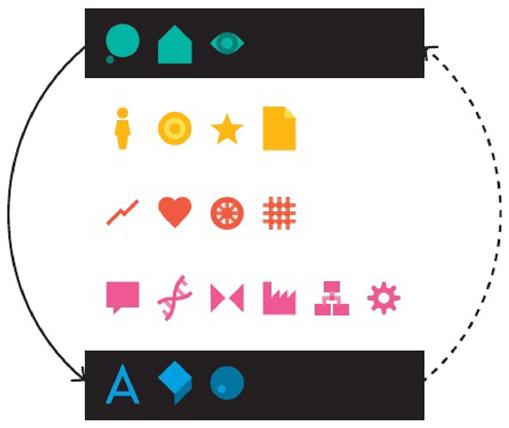
 Deliver
Deliver
Make the finalized outcomes available to the enterprise audiences you designed it for, manage the change processes involved in transitioning to the new state, and set up governance and continuous improvement processes to monitor performance as well as evaluate and refine the design.
Activities
Roll-out the tangible outcomes of the design process, making signs and media, places and things available to external stakeholders and staff members
Deploy all technical components and systems needed to put the design in place
Communicate the changes to the organization and the wider enterprise to all audiences, choosing tools and formats adapted to the nature of the project and its environment
Assess the actual usage of the outcomes, address shortcomings identified, and refine the design to fit reality
Perform long-term evaluations of the effects of the results on the Big Picture qualities addressed with the design initiatives, leading to further refinements
Perform scans of the enterprise as a wider environment to identify upcoming changes, trends or themes to be addressed in a strategic design initiative
Identify the design challenge and preliminary scope for follow-up projects
Challenges
Making the task of rethinking the enterprise everyone’s duty, leveraging ideas and feedback from people all over the enterprise
Being flexible in the way outcomes are managed and interpreted once the results are out the door, but at the same time protecting the essential ideas and underlying concepts
Keeping an open mind for other ways to do things in the enterprise and constantly questioning the decisions made in the design process
Sustaining the design by protecting the assets and outcomes developed as results of the process against weakening support or undesired changes
Rendering
The last phase of the design process is about introducing the results of a design process into the enterprise, as triggers for change and drivers of the transformation towards the intended target state. In the enterprise context, big bang success stories are rare — much more often, successfully designing, implementing, and delivering transformation involves an initial step followed by a longer phase of transitioning and adapting to the new reality.
Therefore, redesigns and project launches are just the beginning of the journey. Strategic design requires continuously improving the Rendering elements after their introduction, based on a measurement of actual usage, adoption, and problems that occur. Informed by collecting quantitative data and performing qualitative observations, minor adjustments can lead to dramatic improvements of the overall performance. It also reveals larger issues or opportunities to be addressed in new projects.
SIGNS
![]() assess how people navigate through systems of signs, consume media and content, and make improvements to support reception and understanding.
assess how people navigate through systems of signs, consume media and content, and make improvements to support reception and understanding.
THINGS
![]() assess how things are actually used, support emerging usage patterns and learn for subsequent versions of the objects made available in the enterprise.
assess how things are actually used, support emerging usage patterns and learn for subsequent versions of the objects made available in the enterprise.
PLACES
![]() assess how places across the enterprise are frequented, how people move through them and what they use them for, and shift them based on these insights.
assess how places across the enterprise are frequented, how people move through them and what they use them for, and shift them based on these insights.
Big Picture
Returning to the top layer of the Enterprise Design framework, the Deliver phase is about managing the transformation process which is the goal of the design process. Design projects can be called strategically relevant only if they have a significant impact on the organization and its enterprise. Therefore, outcomes have to be tied to the Big Picture aspects of the enterprise. This translates into a two-fold challenge.
To have an impact, changes have to reach everyone involved in the transformation process, and impacted by its results. Potential activities to be planned and executed include communication and launch activities, aimed at getting people engaged and committed to the new situation, as well as explaining how things work now. This also requires visible backing from sponsors, executives and other key stakeholders.
The other part of this challenge involves maintenance and governance, long-term change management and performance measurement, making sure the results of a design initiative are sustained in the long run, and continuously refining the design further and launching new projects as needed. In a world of constant change, this might happen sooner than expected.
IDENTITY
set the stage for new or redesigned brand identities and their introduction into the enterprise ecosystem, and make long-term assessments of its impact on culture, behaviors, and perceptions.![]()
ARCHITECTURE
manage the transition to new ways of working in the enterprise, new formal structures and systems to be used, and measure them against performance and quality objectives.![]()
EXPERIENCE
make the rendered outcomes of the design project available to people, and perform long-term studies to evaluate the impact they have for people and their interactions with the enterprise.![]()
I think it’s good to have to do something quickly and not to have time to spoil it.
David Gentleman, Painter
Getting the design process right
The topic of design processes has been the subject of academic research and vivid discussions among practitioners for quite some time. Countless models have been invented to describe how designers work, attempting to turn the professional practice of design into a manageable approach for organizations.
One of the core problems of putting design into such a framework is that it hardly ever fits the reality of design work. Attempts to impose on such work a rational, deterministic model like those used in large engineering projects have largely failed. Through empiric studies it has become clear that most designers do not actually work that way. In order to deal with the underdetermined nature of design work, design processes often are messy and opportunistic. Designers iteratively inquire into the problem space, to make moves in a design space that is constantly being questioned and redefined. While working with a large number of techniques and methods, even for the most methodical designers no single design project is the same.
This is no different for the process discussed in this chapter. Although most strategic design projects go through all the phases and address all the aspects mentioned in one way or another, the way they do that is far from a linear and planned process, and much closer to the non-directed way an artist comes up with an oeuvre, or a college student learns about complex field of study. There seem to be no clear boundaries between the phases, and activities which are at opposite ends of the model in reality might have significant overlap.
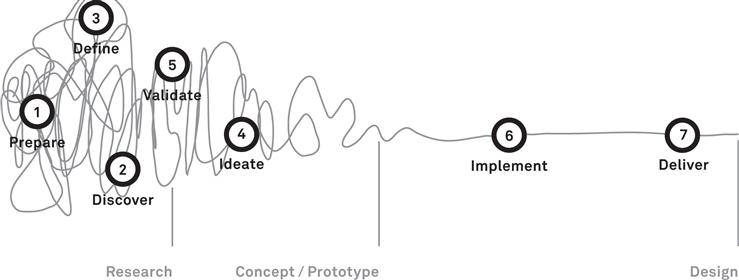
The squiggle, made famous by Damien Newman: starting in a space of great uncertainty and jumping between insights and ideas, conceptual decisions and iterative inquiry. In later phases the work switches from opportunistic exploration to defining and refining a desired target state identified.
Understanding the problem and inventing a solution both happen in parallel, and ideas for potential outcomes can occur in any phase of the process. One project might make you move slowly from research to definition to ideation, developing a thorough understanding of a complex problem before deciding how to proceed. Another may require developing a first shot in a matter of days and co-creatively reshaping it with peers, looping through the process steps in short cycles.
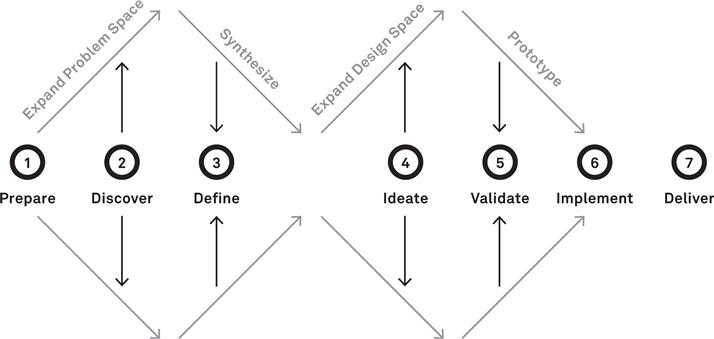
The Double Diamond model from the UK Design Council illustrates how a design process first opens a space to explore the problem, and then consolidates to synthesize potential solutions. In a second diamond the space is opened again to creatively explore ideas, which are turned into prototypes that bring together multiple ideas.
In the enterprise context, figuring out what to do next is often as hard as the actual design challenge. Just as the outcomes have to fit into all sorts of environmental variables, so does the design process itself. Key to this is developing a coherent design strategy, making individual projects a part of a larger program aiming to transform the enterprise.
A design process needs to touch all relevant aspects and bring a project from early ideation to delivery. Key to a successful design project is the constant adaptation of the chosen approach, balancing an opportunistic and dynamic selection of methods and approaches with the constant quest towards a well-defined objective.
Recommendations
Start with an exploration of the context of the design project, consulting with stakeholders, performing research, and developing framed models of the problem space
Formulate the objectives, the principles, and the success conditions that you want to achieve, and envision a desirable future state in concepts and sketches
Create prototypes of the envisioned future enterprise to be validated, refined, and iterated, and turn the most promising results into outcomes and specifications
Consider the delivery of results and the transformation process part of the design initiative, adapt and protect the outcomes, and plan for the next steps
Case Study_Instagram
Providing the best possible experience in mobile photography for sharing your life with your friends and peers.
The story of Instagram, a Silicon Valley startup that was purchased by Facebook for $1 billion in cash and stock, has left many transfixed and inspired. The company created the most successful app for mobile photography, optimizing the entire product for the experience of taking and sharing photos on the go — quickly, effortlessly, and conveniently. Released in October 2010 after just 8 weeks of development, it was used by 24 000 people on its first day. Over the course of a year the number of users rose higher and higher. By the time the company was sold in 2012, the Instagram app was being used by over 30 million registered users.
While this is clearly a tale of overnight success, the way it has been picked up by the media often neglects the fact that the development and release of the software was just one part of a much longer story. The two founders had complementary skills and aspirations, and a shared passion for the design theme they chose to work on — providing the best possible Customer Experience in mobile photography.
Instagram’s success is the result of a holistic design process applied to an enterprise. Instead of putting their effort into new technologies or developing new markets, the team focused on an existing field where they saw a deficit. The idea of photo-sharing was hardly new, and players like Flickr were already successful in that market. Led by Mike Krieger, a technologist co-founder with a User Experience background, they started at the activities of people, designing their product and the company around the User Experience. Unlike the development itself, this process lasted over a year—possibly longer if looking at all activities of preparation and problem definition. It demonstrates well how bumpy and unpredictable such a process can be — the team sprinted through all the stages described in this chapter, applying strategic design in a non-linear, adaptive, and iterative way.
We decided that if we were going to build a company, we wanted to focus on being really good at one thing.
Kevin Systrom
1 Prepare
The Instagram story started with Burbn, an app developed by Kevin Systrom, with a much broader scope. When Mike Krieger joined, the two founders realized that this multitude of features actually made their product too complex, and that they wanted to concentrate on doing just one thing, and that one really well. This resulted in a fundamental change of direction, although the team first continued to develop the original app.
But at the same time, the idea of mobile photo sharing became the story of the startup, so that the two founders started defining their vision of the enterprise. They developed ideas on the focus area, and performed scans of the ecosystem to determine other actors to address, such as Facebook and other social networks becoming external touchpoints for their offering. They developed approaches specific to the content of photography, and services tailored to sharing pictures with friends. This eventually led to a new vision for the experience the company wanted to create for their users. The new name, Instagram, reflected the evolved identity, and a revised architecture supported the new strategic direction based on existing assets from the previous project.
2 Discover
Instagram’s offering is based on an insight into the way people make and share pictures with their handheld devices. Being a startup business, the team gathered this knowledge in a rather informal way, by experimenting with the product and listening to the feedback of their users. This personal but subjective knowledge was backed by usage data, which proved quite revealing when the team discovered that the photo-sharing feature of Burbn was the app’s most used functionality. This made them question the initial idea, and be courageous in changing their plans.
Through these two ways of gaining detailed knowledge, Instagram was able to discover the enterprise elements that they needed to incorporate into their design. They determined the profiles and behaviors of users, and dived deep into the domain of mobile photography to discover the structural elements that mattered to them. They were able to determine a set of functions that matched the context of people taking photos on the go and sharing them.
The Discovery activities were clearly driven by applying a People frame, while questions of the business model were considered less pressing at that point — a prioritization that happens in any design project. Instagram concentrated on researching people’s habits, to make an offering that was meaningful them.
3 Define
The initial design work in a startup is characterized by a large degree of uncertainty, for the whole time that the founders and their team are struggling to define a suitable direction. At Instagram, this changed when they set mobile photography as the new design theme, and radically reduced the scope to just those elements connected to that theme.
Once the basic goal was defined, the team was able to further elaborate their intended solution in terms of the different perspectives. While the primary driver was the people perspective and the User Experience considerations, Instagram defined a business model based on advertising revenue, and defined both the functional scope and the structural elements to execute on the shared vision of their enterprise.
I think the scariest part of a startup is that you don’t have your product defined, you don’t know what you’re working on.
Mike Krieger
This enabled them to work towards a well-defined future state, and make a series of fundamental conceptual design decisions aligned with that vision. The decisions to keep the app free for everyone to install and use, and to make shared pictures public unless the user explicitly decided otherwise, provided the basis for the rapid adoption of Instagram. Their consequent focus on providing a fast and easy sharing mechanism let to the decisions to make classification optional, and remove as many steps and barriers as possible from the interaction.
4 Ideate
Instagram was created in a lean way, by way of experimentation rather than a traditional software development cycle. This emphasis on trying out things was also leading to some of the ideas that make a solid User Experience a remarkable one.
When the team invented the sharing mechanism as the primary communication mode for users, they streamlined the process to adapt it as much as possible to the mobile use context, not bothering users with any details or additional options. This thinking about the context also led to one of the more progressive ideas.
Instead of just enabling people to share photos, Instagram wanted to help them share the greatest moments of their lives. This was in contrast to the bad quality of mobile phone cameras at the time, and also the fact that most users shared snapshots rather than high-quality photos. The solution was the introduction of a set of image filters and effects—hardly a new idea, but a suitable solution for the exact problem to be solved.
Every Monday we would say: what’s a problem that we think we can solve this week around taking mobile photos? By Friday we had a prototype, by Saturday we had it in the hands of users.
Mike Krieger
In putting the conceptual Design Space into outcomes, the Instagram team proved to be obsessive about design details, inspired by years of experience in the field of photography and online communication. This allowed them to bring together all relevant aspects in a coherent Rendering of the app as a service interface and place for the community. Being quite passionate about photography, Kevin Systrom designed every component of their offering with great attention to detail.
5 Validate
From the beginning, the work at Instagram was driven by a culture of purposeful experimentation. Approaching every design challenge as a small research project, the team started with an experiential concern to address, putting their ideas into code to be tested with people within one week. From the basic set of functionality to the selection of which filters to include or how to design the interaction, every detail is the result of a hypothesis that got designed, implemented, and put before users, including different variants subject to A/B test setups.
This enabled them to constantly validate their design in terms of adoption and fit with the functional context. They kept carefully adding structural elements, iteratively refining the vision, and bringing their product closer to it.
With this approach, they were able to drive spectacular user adoption, giving confidence to their investors that they were on the right track and validating their efforts from a business perspective. Although there was no detailed business model defined, they raised $7 million of venture capital, buying them more time to continue their experimentation. The quality of the product and the increasing user adoption eventually led to the Facebook takeover even before any substantial revenues were generated.
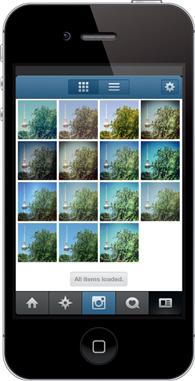
6 Implement
The founding team of Instagram brought together both talent and expertise in technology, Experience Design and photography — the domain of their project. Instead of addressing concerns of product design, technical implementation, marketing or service in isolation, they bridged the gaps between all those aspects and produced a Rendering that executed on a holistic strategy. This strong vision led to important technical decisions, for example, the uploading and processing the data in the background to the sharing interaction exceptionally fast.
All elements were approached as the Anatomy of a greater whole, including the app and its functions, the web site, the background operations, and the integration with external platforms. To be able to implement and test quickly, the team first developed any given component in a generic HTML5 version, iterating and refining any design before making it a part of the native apps for Android and Apple iOS devices. These early prototypes then became the blueprints for the real application, already tested for feasibility and quality.
The experimentation mindset continued well into implementation, flexibly adapting the approach to new situations. The initial release of the Instagram app was a repurposed version of the preceding Burbn project, flexibly leveraging existing technology and assets to follow a new vision for the enterprise.
In the long run you have to build a company. That is way harder than coding a few lines and building the design out. I did all the design for our app. But I had to stop doing that and say to myself: we need an office, we need to recruit people, we need to think about vision, we need to think about where we stand in the ecosystem-and that’s building a company.
Kevin Systrom
7 Deliver
The holistic and strategic design approach at Instagram led to an active consideration of their enterprise ecosystem. This includes the founding team’s valuable network of Bay Area contacts. Instagram reached out to more external actors in their enterprise ecosystem, creating new touchpoints and mindfully extending their services on new platforms such as Android. Although there was strictly no business model defined, there was a great customer acquisition strategy executed in their design.
This vision encompassed not just their product, but also all other parts of the company. They leveraged Apple’s App Store, Facebook, Foursquare, and other platforms as channels to reach more people and make Instagram a part of a larger experience.
They hired a community manager dedicated to driving the conversations with their audience across all communication channels when the team was still quite small, although it must have been tempting to just hire more developers to reduce the coding time. Instead of adding more features, they consciously threw away functions that didn’t contribute to the experience they wanted to support. As adoption increased, their main effort shifted to refactoring their operational and systems architecture to support that growth, expanding their hardware, and optimizing performance. That way, Instagram continuously adapted the Rendering of their enterprise to an evolving Big Picture vision.
